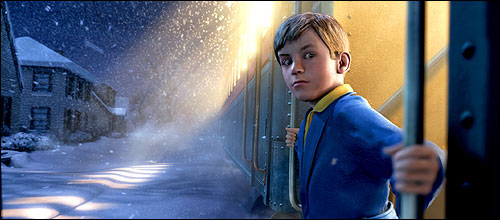‘The Polar Express’ a captivating ride
Chris Van Allsburg’s beloved children’s book presented a problem for filmmakers.
The 1985 holiday tome “The Polar Express” was illustrated with oil paintings, and it had an almost otherworldly quality. Part fairy tale, part Norman Rockwell.
Rendering it in live action seemed impractical, given the movie’s incredible vision of Santa’s wonderland at the North Pole. And traditional animation proved unable to duplicate the painterly aspects of the project.
So what writer-director Robert Zemeckis (“Forrest Gump”) decided to do is employ motion capture technology. Like Andy Serkis’ Gollum in “The Lord of the Rings” trilogy, his actors are fitted with a special suit that allows cameras to “simultaneously record 3-D, high-fidelity facial and body movements.”
Thus the basic performance remains, but the character itself can be altered to look like anyone. This makes it possible for star Tom Hanks to be credited with six major roles.
Anytime a movie is this dependent on new technology, it becomes a science fair exhibit for what works and what doesn’t about the process.
In “The Polar Express,” what works are the details of the images. The stubble on a hobo’s beard. The ice crystals that cling to a train’s underbelly. The enormous herd of caribou that cross the tracks.
The texture and motion of these visuals often achieve qualities that are absolutely lifelike — and very beautiful.
What doesn’t work is the look of the humans.

Hero Boy boards a train headed for the North Pole in the animated holiday tale, The
While minute articles such as hair and skin tones seem naturalistic, the overall effect is still not quite right. There is an artifice that borders on the creepy, especially in regard to the eyes. It’s magnified by the fact that the principal characters are children.
This is supposed to be a delightful Christmas romp, not “Village of the Damned.”
Fortunately, Van Allsburg’s tale is so expertly crafted that it’s easy to get caught up in the story. He really hones in on some of the universal truths about the transition from childhood wonder to teen jadedness.
The plot itself doesn’t change as much as it does exponentially expand. (If the book were to be filmed verbatim it would be about a five-minute flick.)
“On Christmas Eve many years ago,” our young Hero Boy (Hanks) is at the age where he begins doubting the existence of Santa Claus. He is awakened by the sound of a locomotive that pulls in front of his home, and he is whisked away to the North Pole with a handful of other kids his age, including a congenial girl (Nona Gaye) and a lonely boy (Hanks’ “Bosom Buddies” co-star Peter Scolari).
The kids are told by the enigmatic conductor (Hanks again) that when they reach their destination, Santa will personally select one of them to be the recipient of the first gift of Christmas.
The film’s skillful introduction creates plenty of magic. On a dramatic level, Zemeckis really captures the self-doubt of Hero Boy. Visually, he revels in a 1950s-type environment where every frame reveals a fond nostalgia for the era. There’s a wonderful shot of the snowman in front of the boy’s house appearing to wave goodbye as the wind generated by the train blows upon it.
But once inside the train a gaudy musical production number featuring gravity-defying waiters slinging hot chocolate jolts the viewer out of the mood. This sequence comes across like an outtake from “Willy Wonka and the Chocolate Factory.”

Then a character dubbed “Know-It-All” (Eddie Deezen) is introduced who is like a blend between Urkel and that pestering neighbor boy Bruce McCulloch played on “The Kids in the Hall.” This walking encyclopedia is meant to provide comic relief, but he overstays his welcome after only a few sentences.
Other missteps include showcasing an elf that looks and sounds like Steven Tyler of Aerosmith as he screams the melody to “Rockin’ On Top of the World” — one of several forgettable songs cobbled by the team of Glen Ballard and Alan Silvestri. This unnecessary inclusion reeks of marketing, and it sucks the viewer right out of the story. It also just sucks.
The point of “The Polar Express” is that individuals gradually become so desensitized by consumerism and the harsh realities of adulthood that they stop believing in Santa, and ultimately the “spirit” of Christmas. That’s a commendable message. Yet it carries a lot more validity if not flanked by “Polar Express” soundtracks, Burger King tie-ins and bendable action figures.






